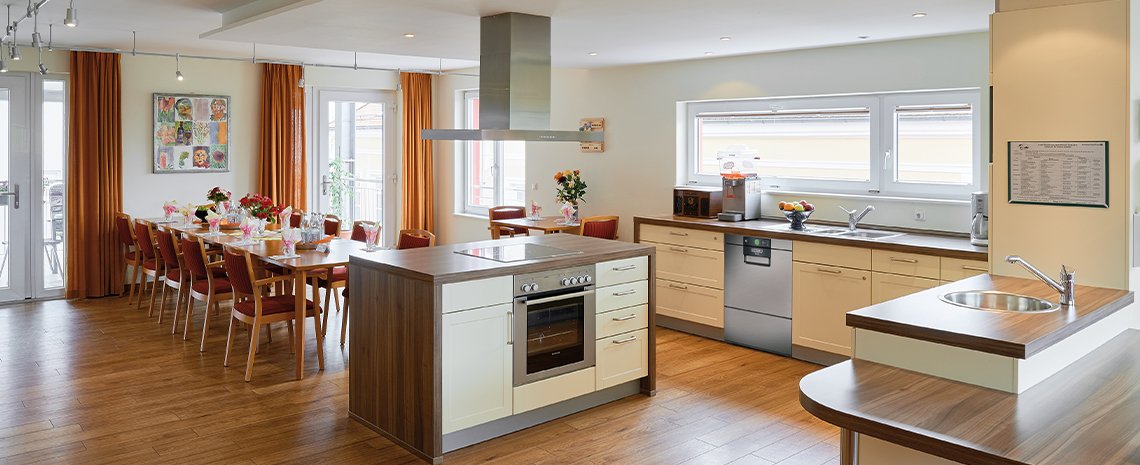

Challenges for the dishwasher in the living area
The living areas in modern nursing and care facilities have changed considerably in recent years and this process will continue in the future. Find out here how new living concepts affect the requirements for a dishwasher.
From the central kitchen to the eat-in kitchen
A few years ago, most of the cooking was still done centrally, the food was brought to the individual wards by transport carts and then the dishes were collected for transport to the central kitchen.
So the dishes were usually washed with a single large hood-type dishwasher or a basket transport dishwasher in a central scullery.
This situation has turned completely around.
Increased demands of the residents on life in care facilities and nursing homes as well as new legal regulations for the construction and operation of the facilities have completely changed everyday life in the homes.
The living groups are furnished like large shared flats. Living and eating areas are combined in a kitchen-living room. Usually there is a large dining table right next to a wooden kitchen, as it would be used by an extended family: Stove, refrigerator and dishwasher are built in and can be used together or by the people present.
In this way, 3-4 meals for 15 people and 2-3 carers are prepared and eaten together daily directly in the wards.
Important to know:
- In the future more meals will be prepared and eaten in small wards.
- The living groups are furnished like modern flat-sharing communities with a jointly used and fully equipped wooden kitchen, which is very similar to the household kitchen.
The dishes are washed up where all eat together
The dirty dishes, such as plates, cups, cutlery and pots are washed directly in the individual kitchens by the supervising staff. The dishwashers are therefore integrated directly into the kitchens and must be able to provide a very high performance 7 days a week.
On average, large quantities of dishes are produced here every day, which cannot be washed in a normal household dishwasher.
That is up to:
- 100 plates and saucers
- 80 cups and glasses
- 100 pieces of cutlery
- 5-6 pots and pans
- Various bowls
On average, 15-20 programmes per day are washed in a dishwasher on a residential ward.
As washing up usually has to take place after a meal, it is imperative that a programme only lasts a few minutes. At the same time, even the highest hygiene requirements should be met in a few minutes and temperatures of 80-85°C should be reached.
Caution:
Household dishwashers cannot meet the requirements for particularly short programme times and very high temperatures!
Important to know:
- In residential wards, 15-20 programmes must be washed every day.
- Short programme times and temperatures of over 80°C are necessary.
Wood kitchens must be protected from steam
Steam is produced during the rinsing process, which causes wood to swell. At home, people try to protect wooden kitchens with special adhesive strips over the door. However, as the washing up in groups of flats is 15 to 20 times more frequent than at home, this protection is not sufficient.
In order to protect high-quality wooden kitchens in the residential groups of old people's homes and nursing homes from steam, no steam should escape when the door is opened.
The special VAPOSTOP technology in our care dishwashers prevents steam escaping from the machine at the end of the washing process.
The value of your kitchen is thus maintained over a long period of time.
Important to know:
Hot steam can damage wooden kitchens.
Steam leakage can be prevented with VAPOSTOP.
This contributes to maintaining the value of your kitchen.
Rinsing like in a bistro
A kitchen in the living area of an old people's home looks like one at home. This is a good thing, because the residents should feel at home.
But unlike in a private household, a kitchen in a residential home is washed up almost like a small restaurant. The amount of washing up is on the level of a small bistro:
- In the morning breakfast for 15-20 persons
- At lunchtime a balanced lunch with starter, main course and dessert
- In the afternoon coffee and cake for all residents
- To conclude, a dinner together
- In between drinks and snacks
The dirty crockery that results cannot be handled by a normal household dishwasher.
You need a professional dishwasher!
With up to 20 washing programmes a day, you need short programme times, fast heat-up times and robust materials. This is exactly what the care dishwasher was developed for.
Important to know:
- In eat-in kitchens you wash as often as in a small bistro.
- For so many dishes you need a professional dishwasher.